Modelled Water and Phosphorus Transports in the Archipelago Sea and through the Åland Sea in the Northern Baltic Sea and Their Links to Water Quality
Abstract
1. Introduction
2. Material and Methods
2.1. Study Areas
2.2. 3-D Model
2.3. Calculations
2.4. Water Quality Data
2.5. Additional Climatic Information
3. Results
3.1. Through the Åland Sea
3.2. Water Flows in the Archipelago Sea
3.3. Phosphorus Flows in the Archipelago Sea
3.4. Water Quality Time Series
3.5. Climatic Observations
4. Discussion
5. Conclusions
Author Contributions
Funding
Institutional Review Board Statement
Informed Consent Statement
Data Availability Statement
Acknowledgments
Conflicts of Interest
References
- Andersen, J.H.; Carstensen, J.; Conley, D.J.; Dromph, K.; Fleming-Lehtinen, V.; Gustafsson, B.G.; Josefson, A.B.; Norkko, A.; Villnäs, A.; Murray, C. Long-term temporal and spatial trends in eutrophication status of the Baltic Sea. Biol. Rev. 2017, 92, 135–149. [Google Scholar] [CrossRef] [PubMed]
- Laamanen, M.; Suomela, J.; Ekebom, J.; Korpinen, S.; Paavilainen, P.; Lahtinen, T.; Nieminen, S.; Hernberg, A. Suomen merenhoitosuunnitelman toimenpideohjelma vuosille 2022–2027; Ympäristöministeriö: Helsinki, Finland, 2021. (In Finnish) [Google Scholar]
- Berninger, K.; Fleming, V.; Huttunen, M.; Iho, A.; Niskanen, L.; Kuosa, H.; Piiparinen, J.; Räike, A.; Salo, M.; Sarkkola, S.; et al. Rannikkovesille tuntuvia kuormitusvähennyksiä; Policy Brief No. 26; Valtioneuvoston selvitys- ja tutkimustoiminta: Helsinki, Finland, 2023. (In Finnish) [Google Scholar]
- Helminen, H.; Juntura, E.; Koponen, J.; Laihonen, P.; Ylinen, H. Assessing of long-distance background nutrient loading to the Archipelago Sea, northern Baltic with a hydrodynamic model. Environ. Model. Softw. 1998, 13, 511–518. [Google Scholar] [CrossRef]
- Hyytiäinen, K.; Huttunen, I.; Kotamäki, N.; Kuosa, H.; Ropponen, J. Good eutrophication status is a challenging goal for coastal waters. Ambio 2024, 53, 579–591. [Google Scholar] [CrossRef] [PubMed]
- Huttunen, I.; Huttunen, M.; Piirainen, V.; Korppoo, M.; Lepistö, A.; Räike, A.; Tattari, S.; Vehviläinen, B. A national-scale nutrient loading model for Finnish watersheds—VEMALA. Environ. Model. Assess. 2016, 21, 83–109. [Google Scholar] [CrossRef]
- Huttunen, I.; Hyytiäinen, K.; Huttunen, M.; Sihvonen, M.; Veijalainen, N.; Korppoo, M.; Heiskanen, A.-S. Agricultural nutrient loading under alternative climate, societal and manure recycling scenarios. Sci. Total Environ. 2021, 783, 146871. [Google Scholar] [CrossRef] [PubMed]
- Fleming, V.; Berninger, K.; Aikola, T.; Huttunen, M.; Iho, A.; Kuosa, H.; Niskanen, L.; Piiparinen, J.; Räike, A.; Salo, M.; et al. Rannikkovesien ravinteiden kuormituskatot ja kuormituksen vähentämisen keinoja: Loppuraportti; Valtioneuvoston selvitys-ja tutkimustoiminnan julkaisusarja: Helsinki, Finland, 2023; Volume 45. (In Finnish) [Google Scholar]
- Lignell, R.; Miettunen, E.; Tuomi, L.; Ropponen, J.; Kuosa, H.; Attila, J.; Puttonen, I.; Lukkari, K.; Peltonen, H.; Lehtoranta, J.; et al. Rannikon kokonaiskuormitusmalli: Ravinnepäästöjen vaikutus veden tilaan—Kehityshankkeen loppuraportti (XI 2015–VI 2018); Finnish Environment Institute: Helsinki, Finland, 2019. (In Finnish) [Google Scholar]
- Miettunen, E.; Tuomi, L.; Myrberg, K. Water exchange between the inner and outer archipelago areas of the Finnish Archipelago Sea in the Baltic Sea. Ocean Dynam. 2020, 70, 1421–1437. [Google Scholar] [CrossRef]
- Miettunen, E.; Tuomi, L.; Westerlund, A.; Kanarik, H.; Myrberg, K. Transport dynamics in a complex coastal archipelago. Ocean Sci. 2024, 20, 69–83. [Google Scholar] [CrossRef]
- Madec, G. and the NEMO System Team. NEMO ocean engine. Sci. Notes Clim. Model. Cent. 2019, 27, 1–323. [Google Scholar] [CrossRef]
- Bonsdorff, E.; Blomqvist, E.M. Biotic couplings on shallow water softbottoms—Examples from the northern Baltic Sea. Oceanogr. Mar. Biol. Annu. Rev. 1993, 31, 153–176. [Google Scholar]
- Von Numers, M. Distribution, numbers and ecological gradients of birds breeding on small islands in the Archipelago Sea, SW Finland. Acta Zool. Fennica 1995, 197, 1–127. [Google Scholar]
- Gurvan, M.; Bourdallé-Badie, R.; Chanut, J.; Clementi, E.; Coward, A.; Ethé, C.; Iovino, D.; Lea, D.; Lévy, C.; Lovato, T.; et al. NEMO Ocean engine. In Notes du Pôle de Modélisation; v4.0, Number 27; Institut Pierre-Simon Laplace (IPSL): Guyancourt, France, 2019. [Google Scholar] [CrossRef]
- Panteleit, T.; Verjovkina, S.; Jandt-Scheelke, S.; Spruch, L.; Huess, V. Quality Information, Document, Baltic Sea Production Centre, Issue 4.0. 2023. Available online: https://data.marine.copernicus.eu/product/BALTICSEA_MULTIYEAR_PHY_003_011/description (accessed on 30 November 2022).
- Copernicus Marine Service Information (CMEMS) North West Shelf multi-year, E.U. Atlantic—European North West Shelf—Ocean Physics Reanalysis. Marine Data Store 2023. Available online: https://data.marine.copernicus.eu/product/NWSHELF_MULTIYEAR_PHY_004_009/description (accessed on 12 February 2022).
- Hersbach, H.; Bell, B.; Berrisford, P.; Hirahara, S.; Horányi, A.; Muñoz-Sabater, J.; Nicolas, J.; Peubey, C.; Radu, R.; Schepers, D.; et al. The ERA5 global reanalysis. Q. J. R. Meteorol. Soc. 2020, 146, 1999–2049. [Google Scholar] [CrossRef]
- SMHI. EHYPE-Model System; Version: ehype3_fgd; SMHI: Norrköping, Sweden, 2020. [Google Scholar]
- Löptien, U.; Mårtensson, S.; Meier, H.E.M.; Höglund, A. Long-term characteristics of simulated ice deformation in the Baltic Sea (1962–2007). J. Geophys. Res. Ocean. 2012, 118, 801–815. [Google Scholar] [CrossRef]
- Nausch, M.; Achterberg, E.P.; Bach, L.T.; Brussaard, C.P.D.; Crawfurd, K.J.; Fabian, J.; Riebesell, U.; Stuhr, A.; Unger, J.; Wannicke, N. Concentrations and Uptake of Dissolved Organic Phosphorus Compounds in the Baltic Sea. Front. Mar. Sci. 2018, 5, 386. [Google Scholar] [CrossRef]
- Andersson, A.; Höglander, H.; Karlsson, C.; Huseby, S. Key role of phosphorus and nitrogen in regulating cyanobacterial community composition in the northern Baltic Sea. Estuar. Coast. Shelf Sci. 2015, 164, 161–171. [Google Scholar] [CrossRef]
- Kirkkala, T.; Helminen, H.; Erkkilä, A.A. Variability of nutrient limitation in the Archipelago Sea SW Finland. Hydrobiologia 1998, 363, 117–126. [Google Scholar] [CrossRef]
- Suomela, J. Kirkkaasta sameaan. Meren kuormitus ja tila Saaristomerellä ja Ahvenanmaalla; Varsinais-Suomen elinkeino-, liikenne-ja ympäristökeskuksen julkaisuja: Turku, Finland, 2011; Volume 6. (In Finnish) [Google Scholar]
- Håkanson, L.; Bryhn, A.C. Eutrophication in the Baltic Sea—Present Situation, Nutrient Transport Processes, Remedial Strategies; Springer: Berlin/Heidelberg, Germany, 2008; 261p. [Google Scholar]
- Yi, P.; Possnert, G.; Aldahan, A.; Hou, X.L.; Bryhn, A.C.; He, P. 129I in the Baltic Proper and Bothnian Sea: Application for estimation of water exchange and environmental impact. J. Environ. Radioact. 2013, 120, 64–72. [Google Scholar] [CrossRef]
- Fonselius, S. Om Österjöns och speciellt Botniska vikens hydrografi. Vatten 1971, 3, 309–324. [Google Scholar]
- Wulff, F.; Rahm, L.; Hallin, A.-K.; Sandberg, J. A nutrient budget model of the Baltic Sea. In A Systems Analysis of the Baltic Sea 2001; Wulff, F., Rahm, L., Larsson, P., Eds.; Springer: Berlin/Heidelberg, Germany, 2001; pp. 353–372. [Google Scholar]
- Savchuk, O.P. Resolving the Baltic Sea into seven subbasins: N and P budgets for 1991–1999. J. Mar. Syst. 2005, 56, 1–15. [Google Scholar] [CrossRef]
- Westerlund, A.; Miettunen, E.; Tuomi, L.; Alenius, P. Refined estimates of water transport through the Åland Sea in the Baltic Sea. Ocean Sci. 2022, 18, 89–108. [Google Scholar] [CrossRef]
- Savchuk, O.P. Large-Scale Nutrient Dynamics in the Baltic Sea, 1970–2016. Front. Mar. Sci. 2018, 5, 95. [Google Scholar] [CrossRef]
- Muchowski, J.; Jakobsson, M.; Umlauf, L.; Arneborg, L.; Gustafsson, B.; Holtermann, P.; Christoph Humborg, C.; Stranne, C. Observations of strong turbulence and mixing impacting water exchange between two basins in the Baltic Sea. Ocean Sci. 2023, 19, 1809–1825. [Google Scholar] [CrossRef]
- Lehmann, A.; Krauss, W.; Hinrichsen, H.-H. Effects of remote and local atmospheric forcing on circulation and upwelling in the Baltic Sea. Tellus 2002, 54A, 299–316. [Google Scholar] [CrossRef]

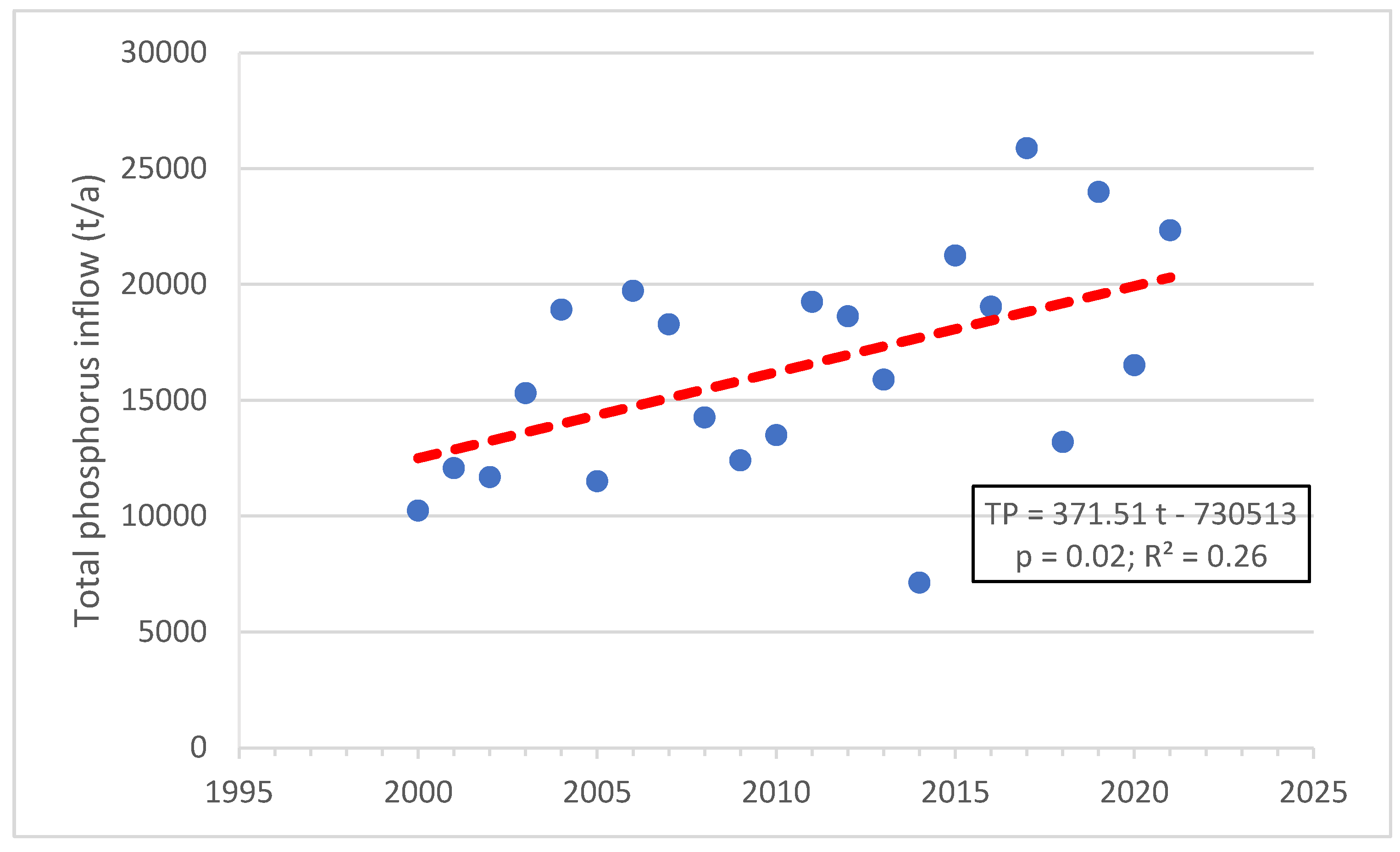
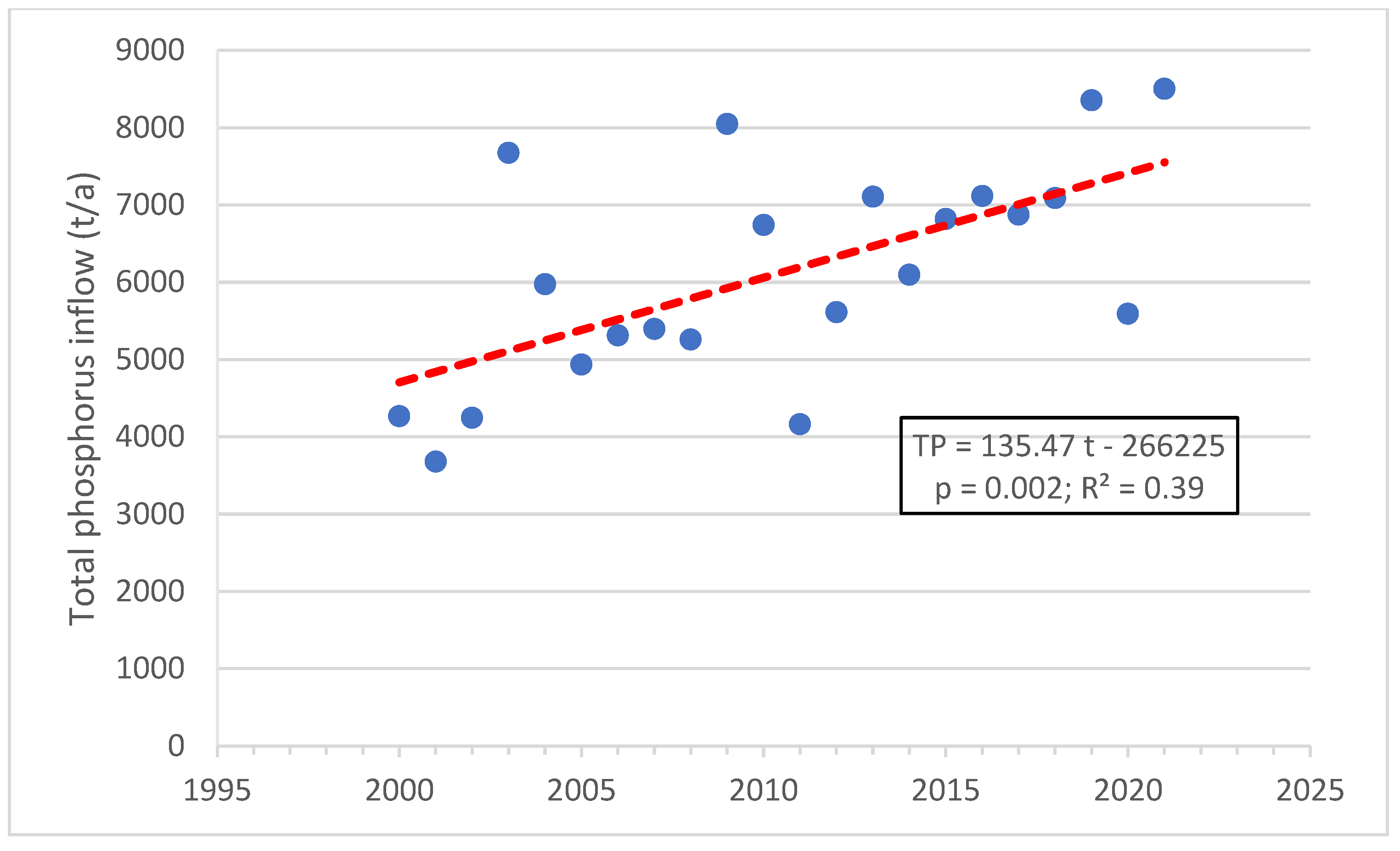



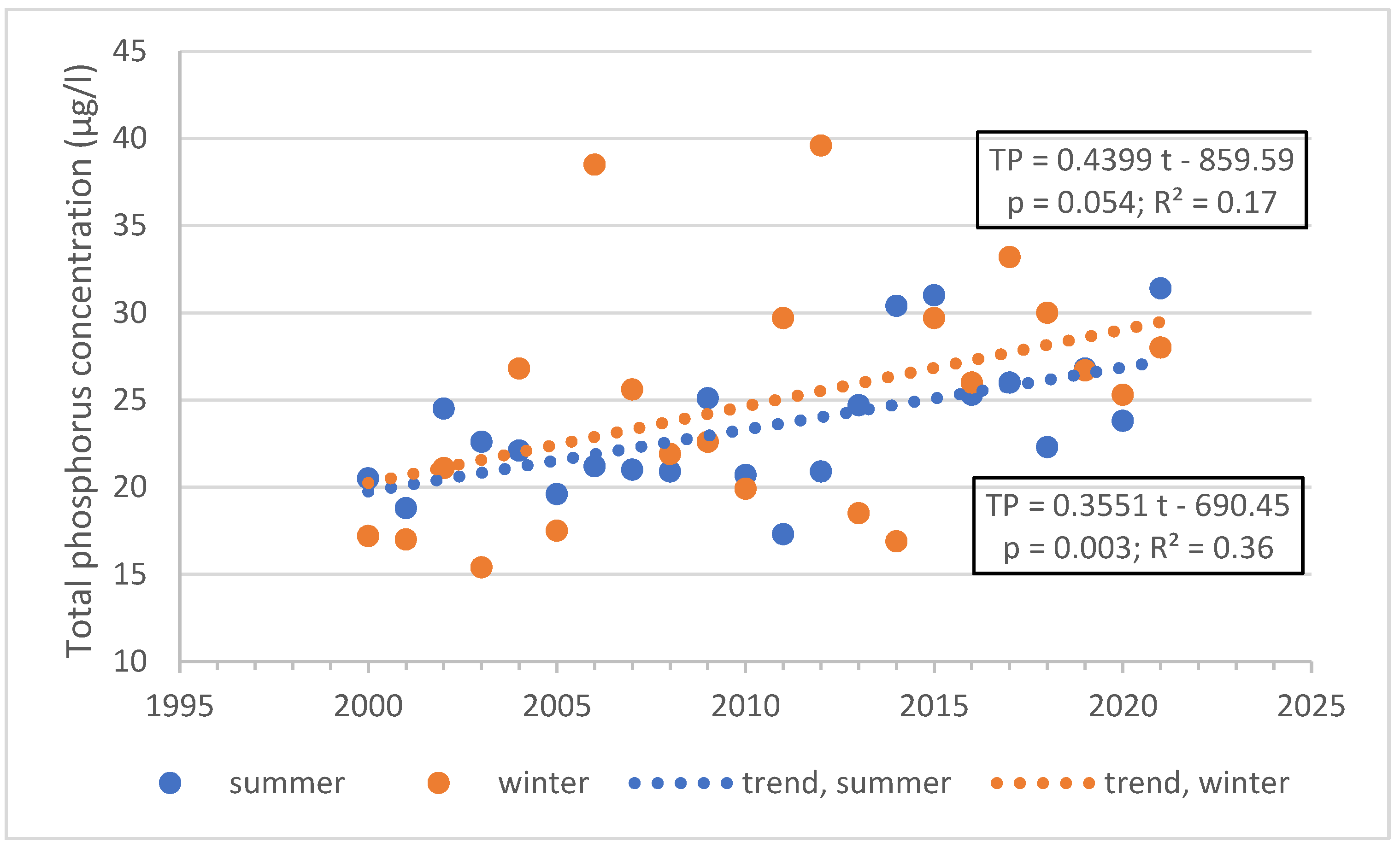
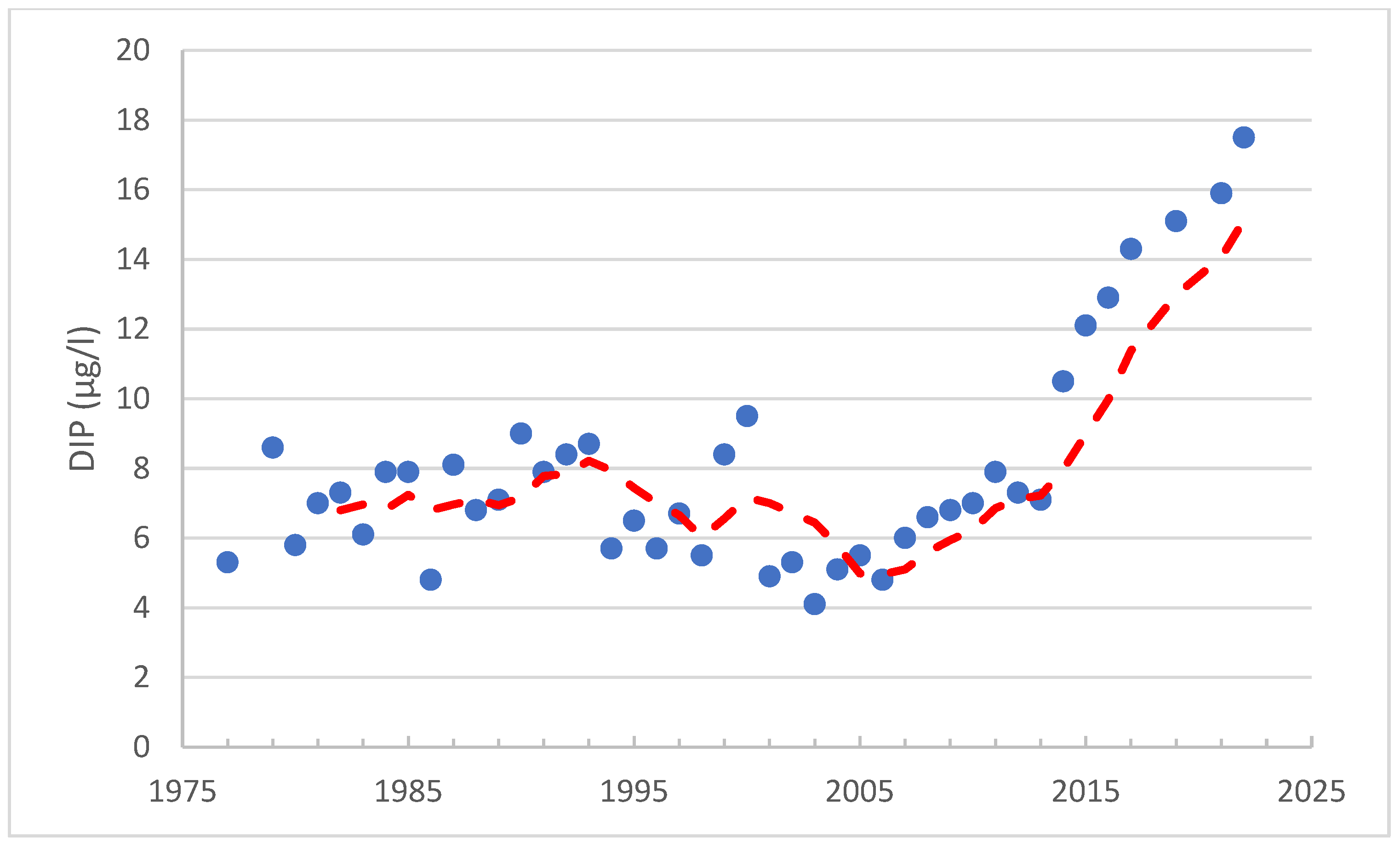
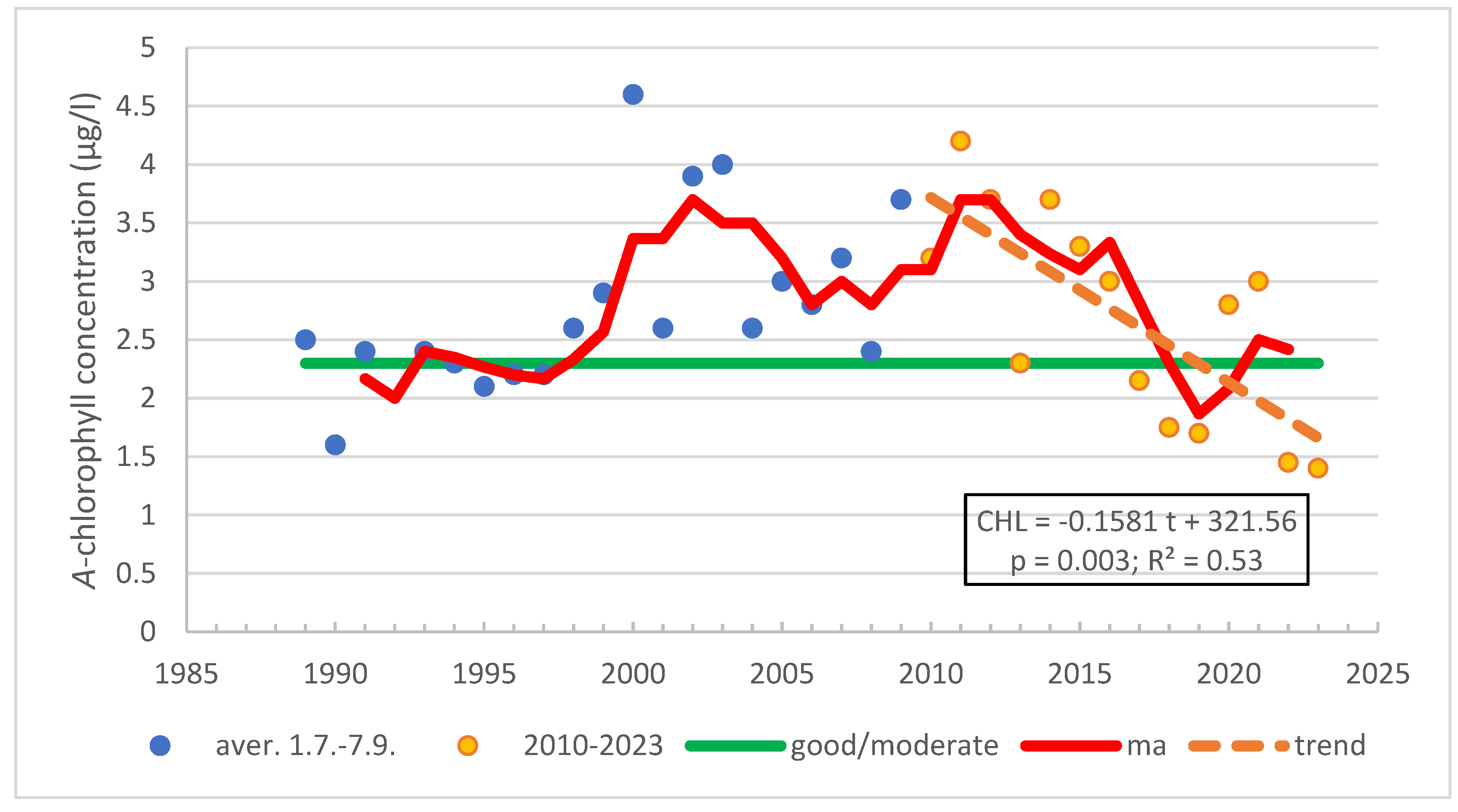
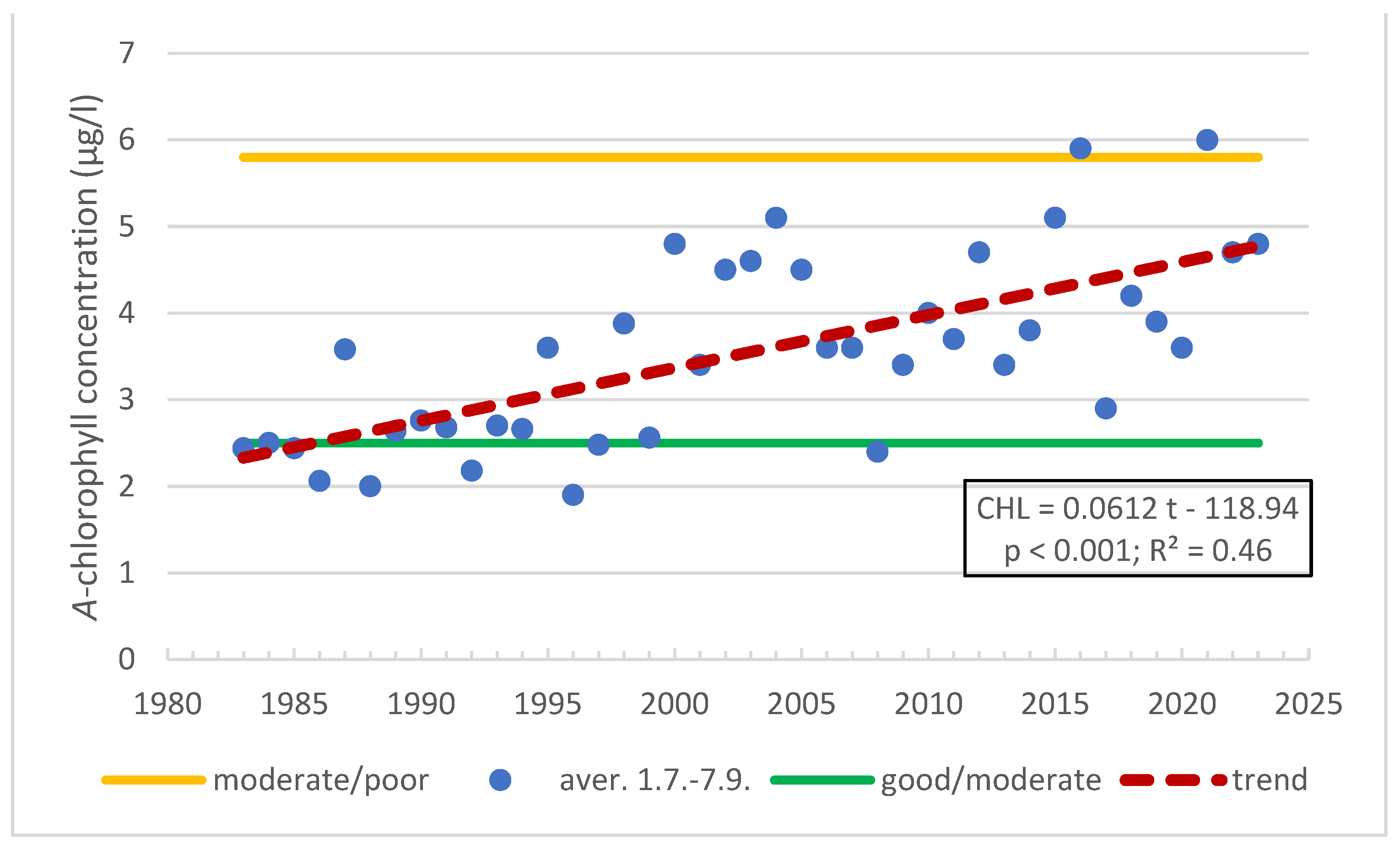
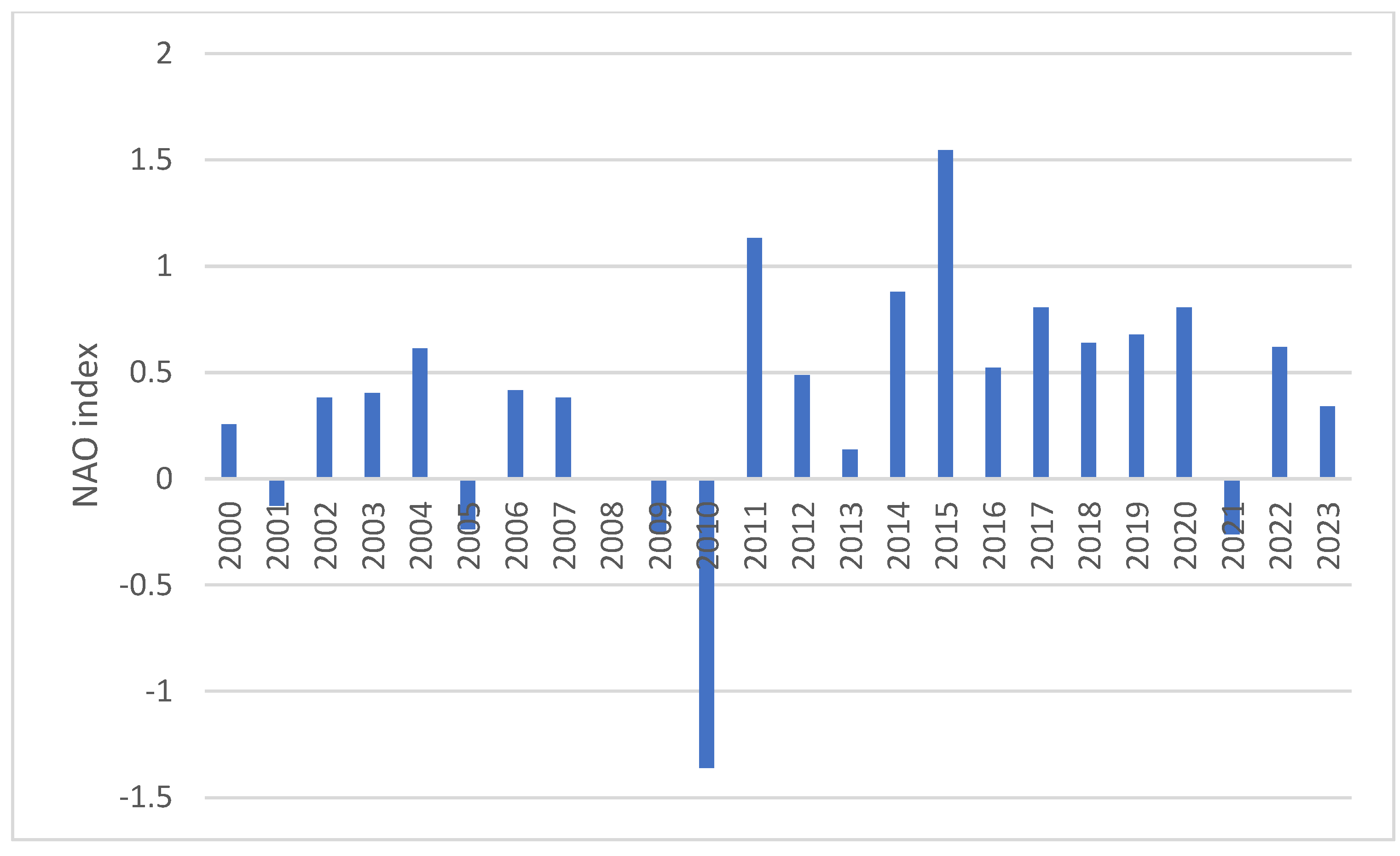

| Period | Inflow (TP t/a) | Outflow (TP t/a) | Difference (TP t/a) |
|---|---|---|---|
| 2000–2009 | 14,434 | 11,105 | 3329 |
| 2010–2014 | 14,876 | 10,597 | 4278 |
| 2015–2021 | 20,313 | 17,829 | 2484 |
| Years 2000–2009 (s) | South | S-M Interface | Middle | M-S Interface | North |
|---|---|---|---|---|---|
| Q (km3) | −31.5 | 23.4 | −8.1 | 4.9 | 3.2 |
| P (µg/L) | 21.3 | 27.4 | 18.5 | 22.6 | 17.3 |
| MF (t) | −670.95 | 641.16 | −149.85 | 110.74 | 55.36 |
| Years 2000–2009 (w) | |||||
| Q (km3) | 43.6 | 12.7 | 56.3 | 2.6 | −58.9 |
| P (µg/L) | 30.5 | 29.5 | 28.6 | 29.3 | 24.3 |
| MF (t) | 1329.8 | 374.65 | 1610.18 | 76.18 | −1431.27 |
| Years 2010–2014 (s) | |||||
| Q (km3) | 7.8 | 20.9 | 28.7 | 5.5 | −34.2 |
| P (µg/L) | 18.3 | 23.2 | 17.6 | 21.9 | 17.8 |
| MF (t) | 142.74 | 484.88 | 505.12 | 120.45 | −608.76 |
| Years 2010–2014 (w) | |||||
| Q (km3) | 80.8 | 19.4 | 100.2 | 5.2 | −105.4 |
| P (µg/L) | 25.9 | 28.8 | 28.5 | 31.5 | 24 |
| MF (t) | 2092.72 | 558.72 | 2855.7 | 163.8 | −2529.6 |
| Years 2015–2021 (s) | |||||
| Q (km3) | −72.6 | 26.3 | −46.3 | 11.3 | 35 |
| P (µg/L) | 21.7 | 26.6 | 15.4 | 20 | 15.5 |
| MF (t) | −1575.42 | 699.58 | −713.02 | 226 | 542.5 |
| Years 2015–2021 (w) | |||||
| Q (km3) | −67.8 | 47.6 | −20.2 | 13.7 | 6.5 |
| P (µg/L) | 29.8 | 29.9 | 26.9 | 28.4 | 20.5 |
| MF (t) | −2020.44 | 1423.24 | −543.38 | 389.08 | 133.25 |
| Summer | Winter | TOTAL | |
|---|---|---|---|
| 2000–2009 | 485.67 | ||
| south part | 120.06 | 94.27 | |
| north part | 16.25 | 255.09 | |
| 2010–2014 | 424.95 | ||
| south part | 122.5 | −204.26 | |
| north part | 16.81 | 489.9 | |
| 2015–2021 | −182.21 | ||
| south part | −162.82 | −53.82 | |
| north part | 55.48 | −21.05 |
| Source | IF TP (t/a) | OF TP (t/a) | IF Wa (km3/a) | OF Wa (km3/a) | Years |
|---|---|---|---|---|---|
| This study | 16,400 | 13,100 | 669 | 879 | 2000–2021 |
| This study | 20,300 | 17,800 | 733 | 949 | 2015–2021 |
| [25] | 16,000 | 10,000 | 755 | 1055 | 1997–2005 |
| [28] | 22,000 | 16,000 | 1000 | 1223 | –2000 |
| [29] | 33,000 | 17,000 | 1009 | 1237 | 1991–1999 |
| [31] | 30,400 | 21,200 | 1009 | 1237 | 2004–2014 |
| [26] | 20,000 | 12,000 | 980 | 1180 | 2009 |
Disclaimer/Publisher’s Note: The statements, opinions and data contained in all publications are solely those of the individual author(s) and contributor(s) and not of MDPI and/or the editor(s). MDPI and/or the editor(s) disclaim responsibility for any injury to people or property resulting from any ideas, methods, instructions or products referred to in the content. |
© 2024 by the authors. Licensee MDPI, Basel, Switzerland. This article is an open access article distributed under the terms and conditions of the Creative Commons Attribution (CC BY) license (https://creativecommons.org/licenses/by/4.0/).
Share and Cite
Helminen, H.; Inkala, A. Modelled Water and Phosphorus Transports in the Archipelago Sea and through the Åland Sea in the Northern Baltic Sea and Their Links to Water Quality. J. Mar. Sci. Eng. 2024, 12, 1252. https://doi.org/10.3390/jmse12081252
Helminen H, Inkala A. Modelled Water and Phosphorus Transports in the Archipelago Sea and through the Åland Sea in the Northern Baltic Sea and Their Links to Water Quality. Journal of Marine Science and Engineering. 2024; 12(8):1252. https://doi.org/10.3390/jmse12081252
Chicago/Turabian StyleHelminen, Harri, and Arto Inkala. 2024. "Modelled Water and Phosphorus Transports in the Archipelago Sea and through the Åland Sea in the Northern Baltic Sea and Their Links to Water Quality" Journal of Marine Science and Engineering 12, no. 8: 1252. https://doi.org/10.3390/jmse12081252
APA StyleHelminen, H., & Inkala, A. (2024). Modelled Water and Phosphorus Transports in the Archipelago Sea and through the Åland Sea in the Northern Baltic Sea and Their Links to Water Quality. Journal of Marine Science and Engineering, 12(8), 1252. https://doi.org/10.3390/jmse12081252




